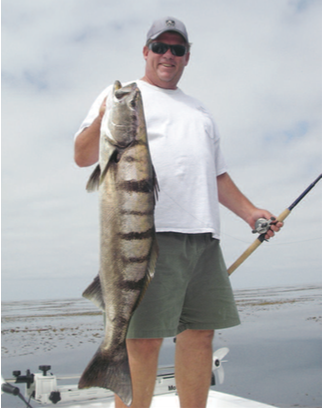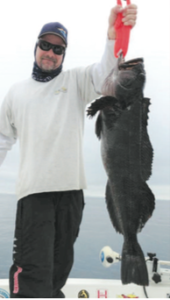
BY CAPTAIN BILL SCHAEFER
So many of us just enjoy fishing, no matter the species that bites. A lot of anglers have certain target fish they really want to chase but can be ecstatic if they get a special surprise species, especially if it’s a giant fish on the end of their line. There are so many species that coexist on natural reefs, rock piles and various drop-offs, as well as man-made structure. All these places hold such an assortment of fish that you never really know what you’re going to bring up to the boat.
Saltwater bass fishermen who target different areas in search of spotted bay bass, sand bass and calicos are probably so fixated with catching bass that they don’t really think or care about what lives in an area along with those bass, until they hook the fish of a lifetime. Do you have the right tackle and do you have strong enough line to land that surprise giant?
Did you change your drag washers recently or are they all stuck together. One quick way to check is to thumb the spool and turn the handle. It shouldn’t be herky-jerky — it should be smooth and the handle should turn with some, but not too much, resistance.

Some of the problems you might face is hooking a giant. You may be skilled enough to play the fish out on lighter line, but if you lose one you may go to heavier tackle for the next cast. I have been fishing a reef for bass and then noticed large marks on the screen. I was sure they were yellowtail, but I ignored them. Then I hooked a fish that spooled my Daiwa Lexa 300 before I could even think about chasing him with the boat. I grabbed a larger 400 size Lexa with more line capacity and 60-pound Maxima braid, tied on the same swimbait and hooked and landed an 18- pound yellowtail. I’m sure there were larger ones in the area.
They were on the prowl for food and eating the swimbait, which happens more than you might think. We even hooked and caught a few more because we were prepared to move up in tackle size. If you hook and get smoked by a giant fish at least once and hopefully not twice, then you had better grab that larger rod you brought to send the next bait down. And, I hope you always bring one on the boat with you. You never know what might be down there. A school of white seabass may have moved into the area.
And speaking of another example, this next one was just that. I was fishing with the late Al Kalin, former owner of Kalin Lures, on the seaward side of San Diego Bay’s Zuniga Jetty. We were catching spotty after spotty in the second section in from the tip. All of a sudden the bass stopped biting. I then hooked a fish that almost spooled me on my light bay gear and came unhooked. Al had a little heavier tackle and landed a small white seabass, then another and another, as we caught fish to 18 pounds. I had heavier tackle for when we were to venture to the kelp later, so I was able to contribute to the 23 white seabass count.
Bay fishing is no exception — always carry a heavier rod and reel combo for those times when you stumble across larger fish then you had planned on fishing for. Spool me once, shame on you — spool me twice, shame on me.
This time of year you can also stumble across large halibut in the bay. You can always have a heavier rod set-up with a wired jighead. I use a piece of single strand 30-pound wire, about 6 inches long and wire one end to a loop and the other to various size jigheads. The wire is about the diameter of 4-pound monofilament. Usually, if you get what I call getting, “halibit off,” then you should change over. The reason you get bit off is that the halibut is large enough to suck in your entire lure and when you set the hook you break off on his teeth. This time of year the halibut are schooled up and spawning, so you tend to catch several in an area.
Many saltwater bass fishermen are already prepared as they have rods with monofilament as well as braid, but you also have to think about line capacity, and a giant can spool you in a second, even with braided line. One more quick example was a trip we took vinto La Jolla boiler rocks for calicos. I was throwing braid and a swimbait, but on a smaller capacity reel. I hooked and landed, but only with some luck, a 33-pound white seabass. He almost spooled me a few times before tuckering out.
If you keep getting broken off when fishing a reef, it’s time to go up in line size and capacity. You may be hooking one giant lingcod after another. You want to land those giants, so start out with heavily line and capacity or quickly change over. The bass on the reef you’re fishing might be line shy. And I can’t blame you for light tackle to get bit with the bass, but the second you get rocked then go up in rod and reel and line size. You need the right tackle to get those surprise fish in.
Let’s review what tackle you take. I’m sorry, but I am going to assume that you all own more than a couple rods as most fishermen do. You may even find a use for a rod and reel that’s sitting in the corner because you think it’s too heavy — break it out, line it up and have it with you next trip.
I usually carry a half dozen rods when fishing, sometimes more. I am someone who likes to be able to just pick up the next rod I need and throw it out. Old tournament fishing habit I guess, but a good habit if you can. You don’t’ really need a ton of rods, just one that’s heavier than the rest.
I normally carry the entire spectrum when out for salty bass: Daiwa DXSB Swimbait rods in 10- to 30-, 12- to 40-, and 20- to 50-pound, with Lexa WN 300 or 400 reels. I load them starting with Maxima UltraGreen monofilament in 12, 15 and 20 pound test. From there I use Daiwa and Maxima braided line from 30- to 65-pound on Daiwa Proteus WN rods. I cross the entire spectrum I need with about 5 or 6 rods. This includes my jig stick, a Daiwa Proteus WN rod in 8-foot, 10-inch with a Lexa 400 with 65-pound braid and a top shot of 30-pound Maxima UltraGreen. I can easily switch to heavier tackle.
It amazes me still how so many different fish eat swimbaits. Different colors surely make a difference, as do the size of the tail and the vibration it sends out to the fish’s lateral line. If you hit that special vibe and whatever they were eating was giving off the same one, then you will get bit no matter the species. That’s why it’s a good idea to carry different companies’ baits. All the designers make their tail vibrate a certain way and you should take advantage of that. It could reward you with a big surprise.
I know, I just told a few old fishing stories, but I want to prepare those of you who don’t think about it that much. I want the rookie-to-moderate fishermen to advance and start bringing in those surprise fish of a lifetime, whether it is a giant white or black seabass to a giant halibut or a big lingcod to monster yellowtail. I know a lot of you think about it, but get too set in your ways. Just be prepared and you will score that surprise fish of a lifetime!



